RESEARCH
Global disparities in the epilepsy treatment gap: a systematic review
Disparités mondiales dans I'insuffisance de traitement de l'épilepsie: revue systématique
Disparidades mundiales en la brecha de tratamiento de la epilepsia: revisión sistemática
Ana-Claire MeyerI,*; Tarun DuaII; Juliana MaIII; Shekhar SaxenaII; Gretchen BirbeckIV
ISan Francisco General Hospital, University of California, 1001 Potrero Avenue (4M62), Box 0870, San Francisco, CA, 94110, United States of America (USA)
IIWorld Health Organization, Geneva, Switzerland
IIIVassar College, Poughkeepsie, New York, USA
IVChikankata Health Services Epilepsy Care Team, Mazabuka, Zambia
ABSTRACT
OBJECTIVE: To describe the magnitude and variation of the epilepsy treatment gap worldwide.
METHODS: We conducted a systematic review of the peer-reviewed literature published from 1 January 1987 to 1 September 2007 in all languages using PubMed and EMBASE. The purpose was to identify population-based studies of epilepsy prevalence that reported the epilepsy treatment gap, defined as the proportion of people with epilepsy who require but do not receive treatment. Negative binomial regression models were used to assess trends and associations.
FINDINGS: The treatment gap was over 75% in low-income countries and over 50% in most lower middle- and upper middle-income countries, while many high-income countries had gaps of less than 10%. However, treatment gaps varied widely both between and within countries. They were significantly higher in rural areas (rate ratio, RR: 2.01; 95% confidence interval, Cl: 1.40-2.89) and countries with lower World Bank income classification (RR: 1.55; 95% Cl: 1.32-1.82). There was no significant trend in treatment gap over time (RR: 0.92; 95% Cl: 0.79-1.07).
CONCLUSION: There is dramatic global disparity in the care for epilepsy between high- and low- income countries, and between rural and urban settings. Our understanding of the factors affecting the treatment gap is limited; future investigations should explore other potential explanations of the gap.
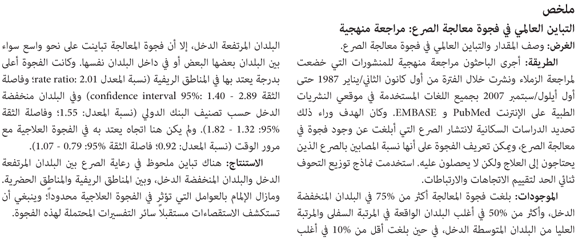
RÉSUMÉ
OBJECTIF: Décrire l'ampleur et les variations de I'insuffisance du traitement de l'épilepsie dans le monde.
MÉTHODES: A I'aide de PubMed et d'EMBASE, nous avons realise une revue systématique de la littérature examinee par des pairs et publiée entre le 1er Janvier 1987 et le 1er septembre 2007 dans toutes les langues. Uobjectif était d'identifier des études en population de la prevalence de l'épilepsie indiquant I'insuffisance du traitement de cette maladie, définie comme la proportion des personnes épileptiques ayant besoin d'etre traitées, mais ne recevant pas de traitement. Des modeles par regression binomiale negative ont été utilises pour évaluer les tendances et les associations.
RÉSULTATS: L'insuff¡sanee du traitement de l'épilepsie dépassait 75 % dans les pays à faible revenu et 50 % dans la plupart des pays à revenu moyen inférieur et moyen supérieur, alors que dans de nombreux pays à revenu elevé, cette insuffisance était inférieure à 10 %. Néanmoins, I'insuffisance du traitement variait fortement d'un pays à l'autre et au sein d'un même pays. Elle était significativement plus importante dans les zones rurales (risque relatif, RR: 2,01 ; intervalle de confiance à 95 %, IC : 1,40-2,89) et dans les pays appartenant à Ia classe de revenu inférieure de la Banque mondiale (RR : 1,55 ; IC à 95 % : 1,32-1,82). On n'a relevé aucune tendance significative de I'insuffisance du traitement de l'épilepsie au cours du temps (RR : 0,92 ; IC à 95 % : 0,79-1,07).
CONCLUSION: II existe à travers le monde des disparités considerables dans les soins dispenses aux épileptiques, et notamment entre les pays à revenu faible et elevé et entre les environnements ruraux et urbains. Notre comprehension des facteurs influant sur I'insuffisance du traitement est limitée : dans le cadre d'investigations futures, il conviendrait d'étudier d'autres explications possibles de cette insuffisance.
RESUMEN
OBJETIVO: Describir la magnitud y las diferencias de la brecha de tratamiento de la epilepsia a nivel mundial.
MÉTODOS: Através de PubMed y EMBASE, se hizo una revisión sistemática de los artículos revisados por homólogos publicados entre el 1 de enero de 1987 y el 1 de septiembre de 2007. La finalidad era encontrar estudios poblacionales sobre la prevalência de la epilepsia que informaran acerca de la brecha de tratamiento de esa enfermedad, definida como la proporción de personas afectadas que necesitan pero no reciben tratamiento. Las tendencias y relaciones se evaluaron mediante modelos de regresión binomial negativa.
RESULTADOS: La brecha terapéutica era superior al 75% en los países de ingresos bajos, y superior al 50% en la mayoría de los países de ingresos medios bajos y medios altos, mientras que muchos países de ingresos altos presentaban brechas inferiores al 10%. Sin embargo, la magnitud de la brecha terapéutica difería ampliamente tanto entre los países como en cada país. Era significativamente mayor en las zonas rurales (razón de tasas, RT: 2,01, intervalo de confianza del 95%: 1,40-2,89) y en los países incluidos en la categoría de ingresos bajos del Banco Mundial (RT: 1,55, IC95%: 1,32-1,82). No se observó ninguna tendencia significativa de la brecha a lo largo del tiempo (RT: 0,92, IC95%: 0,79-1,07).
CONCLUSÍON: En lo referente al tratamiento de la epilepsia, existe una enorme disparidad mundial entre los países de altos y de bajos ingresos, y entre las zonas rurales y las urbanas. Nuestros conocimientos sobre los factores que determinan esa brecha terapéutica son limitados, y en las investigaciones futuras se deberían estudiar otras posibles explicaciones de la misma.
Introduction
Epilepsy affects 50 million people worldwide, and 80% of them live in the developing world.1 An individual with epilepsy suffers recurrent seizures unprovoked by acute brain insults or metabolic derangements. Seizures are characterized by a brief period of uncontrolled involuntary shaking. They may be partial, involving only one part of the body, or generalized, involving the entire body, and they may be accompanied by loss of consciousness and of control of bowel or bladder function. Some individuals continue to have frequent seizures despite optimal treatment with anti-epileptic drugs. However, more than 70% of patients who are treated achieve long-term remission or freedom from seizures, usually within 5 years of diagnosis.2
Cost-effective epilepsy treatments are available and an accurate diagnosis can be made without technological equipment. Nonetheless, avast majority ofindividuals with epilepsy in many resource-poor regions do not receive treatment.3-5 Untreated epilepsy is a critical public health issue, as people with untreated epilepsy face potentially devastating social consequences and poor health outcomes. Due to stigma, many persons with epilepsy have lower employment and education levels and lower socioeconomic status. For example, children with epilepsy who have a seizure at school may be dismissed, while adults may be barred from marriage or employment.16 In addition, persons with epilepsy have poor health outcomes, including greater psychological distress, more physical injuries such as fractures and burns, and increased mortality.7-12
The epilepsy treatment gap, defined as the proportion of people with epilepsy who require treatment but do not receive it, has been proposed as a useful parameter to compare access to and quality of care for epilepsy patients across populations.13,14 Prior anecdotal and descriptive estimates suggest a treatment gap of more than 80% in many low-income countries,13-15 yet one recent systematic review and meta-analysis suggests that the treatment gap in developing countries is as low as 56%.16This intriguing discrepancy may be due to the methodological limitations of the prior systematic review, which had an excessively narrow search strategy, included only English-language articles, and used meta-analytic techniques to generate a population estimate of the treatment gap. First, the search strategy focused on "treatment gap" and "treatment status". Many epilepsy prevalence studies report treatment data, but as the term "treatment gap" only recently came into usage in the research literature,13 many studies with treatment gap data may have been missed using this search strategy. Second, many studies, particularly from low-income countries, are published in local rather than international journals. By not including languages other than English, many studies with treatment gap data may have been missed. Finally, the use of meta-analytic techniques to generate a unitary estimate of the treatment gap may have biased the estimates for two reasons: first, there was considerable unexplained heterogeneity among treatment gap estimates, and second, included studies were conducted in populations that were not representative of developing countries as a whole.
In this systematic review and analysis of the variation in the epilepsy treatment gap, we have greatly expanded the scope of the systematic review by searching for population-based epilepsy prevalence studies in all languages. We have also described the magnitude of the treatment gap worldwide and conducted some preliminary assessments of its variation.
Methods
We conducted a systematic review of the peer-reviewed literature published in all languages from 1 January 1987 to 1 September 2007 using PubMed and EM-BASE. Search terms included PubMed MeSH terms and keywords "epilepsy" AND "morbidity," OR "epilepsy" AND "delivery of health care," OR "treatment gap" AND "epilepsy". This generated 14 985 titles. Hand searching of 68 reviews of epilepsyprevalence generated an additional 30 unique titles. All titles were reviewed to identify potential epilepsy prevalence studies, then 499 abstracts and 253 full manuscripts were reviewed to identify population-based epilepsy prevalence studies (Fig. 1). Data were extracted and reviewed independently by two authors.
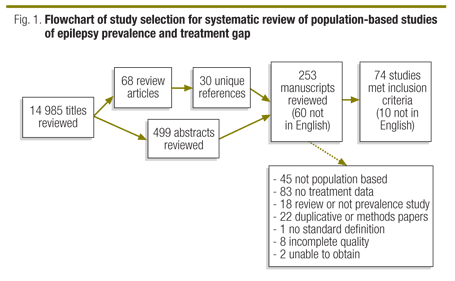
To be included in the analysis, epilepsy prevalence studies had to be based on a population-based sample and apply a standard definition of epilepsy. A population-based sample was defined as a door-to-door or other probability sample of a regional or national population. Studies in which the sample was drawn from a medical care setting were excluded to avoid underestimating the treatment gap. School-based populations in countries where school attendance was low were also excluded. Finally, studies based on methods shown to produce unreliable community-based samples in epilepsy prevalence studies, such as the key informant method, were excluded as well.17,18
The standard definition of epilepsy had to be internally consistent and to differentiate epilepsy from provoked seizures, febrile seizures and isolated seizures. For lifetime epilepsy, acceptable definitions included a history of more than one unprovoked seizure. For active epilepsy, acceptable definitions included a history of more than one unprovoked seizure and either recent seizures (within the previous 5 years) or current use of anti-epilepsy medication. If the treatment gap or other information was missing from the manuscript, we tried to contact the authors to obtain the information before excluding the study.
Further analysis of the variation in epilepsy treatment gap estimates was limited to studies of active epilepsy, as studies using lifetime epilepsy could overestimate the treatment gap. For example, some individuals captured when considering the lifetime prevalence of epilepsy may be in terminal remission and off treatment.19 Including them in the estimates would overestimate the treatment gap because by not being on anti-epileptic drugs, these individuals are receiving the recommended standard of care.
We analysed the variation in the epilepsy treatment gap by study area (urban versus rural), country income category and year. We used negative binomial regression models to examine associations and trends and used separate models to examine the association between treatment gap and study area, country income category and year. Treatment gaps were expressed as the number of untreated persons with active epilepsy, with the number of persons having active epilepsy used as the exposure variable. Studies were classified as rural or not rural based on the site description in the methods section of the manuscripts. Countries were classified as low, lower middle, upper middle or high-income economies using World Bank criteria.20 Prevalence year was extracted from the manuscripts; if no prevalence year was provided, the year of publication was used instead. World Bank income category and prevalence year, arranged in 5-year intervals, were treated as ordered categorical variables. Stata 10 (StataCorp LP, College Station, TX, United States of America) was used for the analysis. Significance level was set at P< 0.05.
Results
Our search yielded 157 epilepsyprevalence studies that met our stated inclusion criteria, but 83 (nearly 53%) of them did not collect treatment gap data. Therefore, our final sample consisted of 74 studies representing 38 countries (Table 1 and Table 2, available at: http://www.who.int/bulletin/vol-umes/88/4/09-64147/en/index.html). Of note, we reviewed 60 articles in languages other than English (Chinese, English, French, German, Italian, Japanese, Portuguese, Russian, Spanish and Turkish) and 10 of them were included in the study. Manuscripts included in our final sample were published in English, French, Spanish and Turkish.
Active epilepsy was used to estimate the treatment gap in 54 populations from 28 countries (Table 1) and lifetime epilepsy was used to estimate the treatment gap in 18 populations from 16 countries (10 of which were not among the countries for which the active epilepsy gap was estimated). (Table 2). Studies spanned nearly 30 years, from 1978 to 2006, and originated across the globe, including Africa, Asia, Europe and North and South America. Study populations differed markedly in terms of type of study area (urban versus rural), sample size and degree to which they represented the entire country. Nearly 47% (34/72) of the included studies were drawn from rural populations. Treatment gaps were calculated from samples ranging from 5 to 1175 epilepsy cases. Samples were drawn from many different populations; some were nationally representative, while others represented small ethnic groups, indigenous groups, schoolchildren or military recruits.
Treatment gaps estimated from active epilepsy prevalence ranged widely between countries. Gaps were 10% or less in China (Province of Taiwan), Norway, Singapore, the United Kingdom of Great Britain and Northern Ireland, the United States of America, and select populations in Argentina, Brazil and France. In sharp contrast, treatment gaps were greater than 95% in China, Ethiopia, the Gambia, the Lao People's Democratic Republic, Nigeria, Pakistan, Panama, Togo, Uganda, the United Republic of Tanzania and Zambia (Fig. 2). A wide range of treatment gaps was observed within countries as well. For example, treatment gaps in India ranged from 22% in an urban middle- income population to 90% in a sample of rural villages.18,21
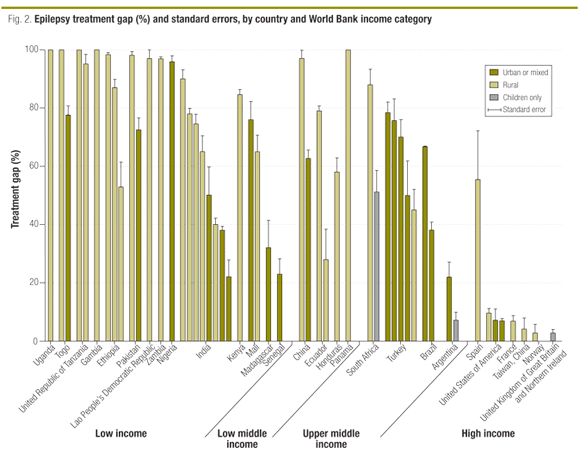
Like treatment gaps estimated from active epilepsy prevalence, the gaps estimated from lifetime prevalence also ranged widely, from 6% in Singapore to 100% in Bolivia (Fig. 3).22,23 In most cases, gaps estimated from lifetime prevalence were larger than those estimated from active epilepsy prevalence. However, paradoxically, in a few low-income countries such as Pakistan and India, the treatment gap estimated from lifetime prevalence was smaller than some or all of the gap estimates based on active epilepsy prevalence.
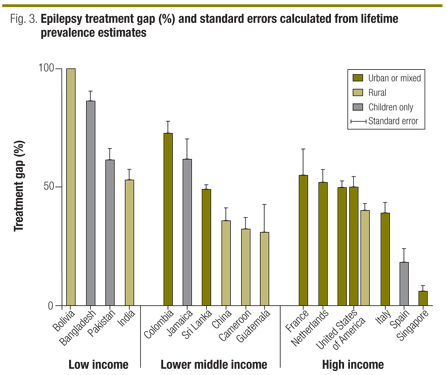
For the analysis of the variation in the treatment gap, only studies estimating the gap from individuals with active epilepsy were used. In these studies, rural populations had treatment gaps nearly twice as high as populations from towns or from suburban, semi-urban or urban locations (rate ratio, RR:2.01; 95% confidence interval, Cl: 1.40-2.89; Z: 3.77; P < 0.001) (Fig. 4). For example, in India the treatment gap ranged from 40 to 90% in rural areas and from 22 to 50% in mixed, suburban and urban populations.18,21,24,25 Similar trends were observed in Brazil, China, Pakistan and Togo. However, there were a few exceptions: in a rural population from Rajasthan, India, the treatment gap was 40% (the third lowest in India),25 while in a rural population of Mali it was 65% (versus 76% in an urban population).26,27
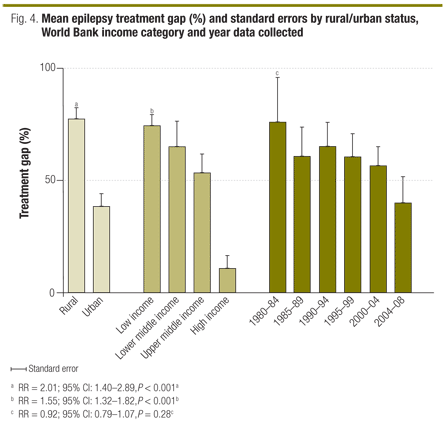
There was a significant trend towards larger epilepsy treatment gaps in countries with lower incomes; for every one-level decrease in World Bank income category, the treatment gap increased by a factor of 1.55 (95% CI: 1.32-1.82; Z: 5.34; P < 0.001) (Fig. 4). However, within high-income countries, larger gaps were found in select populations. In a small sample from Spain, the treatment gap was greater than 50%, while among the Guaymi Indians in Panama the gap was 100%.28,29 Similarly, select populations in low-income countries had surprisingly small gaps; suburban and urban populations in India, Madagascar and Senegal had treatment gaps of less than 30%.21,30-32
Direct comparisons of treatment gaps over time were difficult to carry out because of differences in study methods and populations. In Ethiopia, two studies in the same population in which the same methods were used showed a gap of 98% in 1986-1988 and a gap of 87% among new cases identified during a repeat survey in 1990.33,34 Overall, treatment gaps decreased from 1980 to the present, but no significant trend over time was detected (RR: 0.92; 95% CI: 0.79-1.07; Z: -1.08; P=0.28).
Discussion
The results of this systematic review of the literature suggest that there are dramatic global disparities in the care and treatment ofepilepsypatients. Treatment gaps for active epilepsy exceeded 75% in most low-income countries and 50% in most lower middle- and upper middle-income countries. In stark contrast, many high-income countries had gaps of less than 10%. However, treatment gaps varied widely, both between and within countries.
Our search methods resulted in more comprehensive estimates of the epilepsy treatment gap than those employed in previous studies. First, our systematic and thorough search strategy and rigorous inclusion criteria ensured the quality of included studies. Second, our wider search strategy, which focused on epilepsy prevalence rather than on the treatment gap, captured 26 more studies than did a recent systematic review,16 even when we applied the same inclusion criteria. Third, our search of the non-English-language literature led to an additional 10 studies.
The subsequent analysis of the variation in the treatment gap showed significantly higher gaps in rural areas and lower-income countries. These findings are consistent with those for other health indicators, such as the rates of vaccination coverage and of maternal, infant and under-five mortality, which suggest wide disparities in care between rural and urban areas and between high- and low-income countries.35-40 On the other hand, epilepsy treatment gaps have decreased from 1980 to the present, though the trend is not statistically significant.
While intriguing, these preliminary analyses do not fully explain the variation in the treatment gap, which may additionally reflect local or regional differences in access to and quality of epilepsy care or in the availability of individual or regional economic resources.13,16 In addition, cultural differences in the stigma associated with epilepsy may determine whether an individual seeks care for epilepsy or not.2,6
In our analysis, we found that the treatment gap varied widely both within and between countries and that it was significantly associated with country income classification and a population's status as urban or rural. Similarly, prior studies of the gap demonstrated significant heterogeneity in treatment gap estimates.16 The wide variation among estimates as well as the systematic variation as a function of selected covariates suggests that meta-analytic techniques may not be appropriate for obtaining overall population estimates of the epilepsy treatment gap. Further study into the influence of macroeconomic and microeconomic factors and of resources for the care of people with epilepsy and other neurologic disorders will be critical to understanding the reasons for this heterogeneity. Accounting for the systematic variation in the gap is essential to creating summary estimates of the gap. Combining demographic approaches with multiple imputation techniques could generate more representative gap estimates.
Our data set had several limitations. First, our sample was limited because we excluded epilepsy prevalence studies that did not collect treatment information (nearly half of those identified) or that calculated the gap from a potentially biased sample, such as clinic or hospital patients. Using lifetime prevalence to calculate the gap could have resulted in an overestimate, so we only included data on lifetime prevalence for descriptive purposes.
Furthermore, our ability to generate national treatment gap estimates was limited. Most treatment gap estimates were based on data from selected populations that were not representative of the nation as a whole. A sample not representative of the population was not a criterion for exclusion because it was a limitation of nearly all the studies reviewed. Among the studies we included were several performed in a rural or urban area only,34,41 among the elderly or children exclusively,27,42,43 in areas with a high prevalence of epilepsy,44 in military22,45 or school populations,46 or in regions populated by only one or a few ethnic groups.7,47 Likewise, several included studies had been conducted in ethnic or social groups that differed from the population of the country as a whole. Examples include the Parsi community in India,21 the Bakairi indians from Brazil,44 the Zay society in Ethiopia48 or the Guaymi indians of Panama.28 Therefore, caution should be exercised in extrapolating treatment gap estimates from such select populations to the country as a whole without proper adjustment.
Although we tried to minimize variation by means of our inclusion criteria, study methods - case ascertainment, sampling technique, the definitions of active epilepsy and of adequate treatment, etc. - differed widely among studies. The quality and comparability of treatment gap data could be improved by applying standard definitions for adequate treatment and active epilepsy and by using more nationally representative population-based samples to generate active epilepsy prevalence and estimate the treatment gap. Better insight into the causes of this gap would be obtained if epilepsy prevalence studies routinely collected information on other sociode-mographic characteristics, the availability and accessibility of local or regional health services and treatment, and the stigma associated with seeking care.
Conclusion
In summary, our systematic review of the epilepsy treatment gap worldwide shows a dramatic global disparity in the care of epilepsy patients between high- and low-income countries and between rural and urban settings. Epilepsy is a common and potentially serious neurological disorder that can be diagnosed and treated inexpensively. Historically, epilepsy has received little public health attention despite poor health outcomes and potentially devastating social consequences from untreated disease. In recent years, many countries have undertaken initiatives to decrease the epilepsy treatment gap, notably the demonstration projects such as the Global Campaign Against Epilepsy, conducted jointly by the International League against Epilepsy, the International Bureau for Epilepsy and the World Health Organization. Large community based trials in Brazil and China have demonstrated that epilepsy can be treated with inexpensive and effective drugs at the community level by primary health professionals with basic training.5,49 Increased commitment by the global health community is needed to reduce the treatment gap and thereby reduce the potentially devastating social consequences and poor health outcomes resulting from untreated epilepsy.
Acknowledgements
We thank John Boscardin, Associate Professor of Medicine and Biostatistics, for his help with the statistical analysis.
Funding: Ana-Claire Meyer: Veterans Affairs/Robert Wood Johnson Clinical Scholars Program, American Academy of Neurology Practice Research Training Fellowship. Gretchen Birbeck: The Global Burden of Diseases, Injuries, and Risk Factors Study.
Competing interests: None declared.
References
1. Leonardi M, Ustun T. The global burden of epilepsy. Epilepsia 2002;43(Suppl 6):21-5.dol:10.1046/j. 1528-1157.43.S.6.11 .x PMID:12190974
2. de Boer HM, Mula M, Sander JW. The global burden and stigma of epilepsy. Epilepsy Behav 2008;12:540-6. dol:10.1016/j.yebeh.2007.12.019 PMID:18280210
3. Kwan P, Brodle M. Phenobarbltal for the treatment of epilepsy in the 21st century: a critical review. Epilepsia 2004;45:1141-9. doi:10.1111/J.0013-9580.2004.12704.x PMID:15329080
4. Chlsholm D; WHO-CHOICE. Cost-effectiveness of first-line antleplleptlc drug treatments in the developing world: a population-level analysis. Epilepsia 2005:46:751-9. dol:10.1111/j.1528-1167.2005.52704.x PMID:15857443
5. Wang WZ, Wu J, Ma G, Dal X, Yang B, Wang T et al.Efficacy assessment of phenobarbltal in epilepsy: a large community-based intervention trial in rural China. Lancet Neurol2006;5:46-52. doi: 10.1016/S1474-4422(05)70254-4 PMID:16361022
6. Basklnd R, Blrbeck GL. Epilepsy-associated stigma in sub-Saharan Africa: the social landscape of a disease. Epilepsy Behav 2OO5;7:G8-73. dol:10.1016/j. yebeh.2005.04.009 PMID:15978874
7. Blrbeck G, Chomba E, Atadzhanov M, Mbewe E, Haworth A. The social and economic Impact of epilepsy in Zambia: a cross-sectional study. Lancet Neurol 2007:6:39-14. doi: 10.1016/S1474-4422(06)70629-9 PMID:17166800
8. Blrbeck GL. Seizures in rural Zambia. Epilepsia 2000;41:277-81. doi: 10.1111 /j. 1528-1157.2OOO.tbOO156.x PMID: 10714398
9. Jilek-Aall L, Rwiza H. Prognosis of epilepsy in a rural African community: a 30 year follow-up of 164 patients in an outpatient clinic in rural Tanzania. Epilepsia 1992:33:645-50. doi:10.1111/j. 1528-1157.1992.tb02341.x PMID:1628578
10. Amoroso C, Zwi A, Somervllle E, Grove N. Epilepsy and stigma. Lancet 2006:367:1143-1. dol:10.1016/S0140-6736(06)68503-6 PMID:16616554
11. Jacoby A, Snape D, Baker G. Epilepsy and social Identity: the stigma of a chronic neurological disorder. Lancet Neurol 2005;4:171-8. PMID:15721827
12. Ding D, Wang W, Wu J, Ma G, Dai X, Yang B et al.Premature mortality in people with epilepsy in rural China: a prospective study. Lancet Neurol 2006:5:823-7. dol:10.1016/S1474-4422(06)70528-2 PMID:16987728
13. Kale R. Global Campaign against Epilepsy: the treatment gap. Epilepsia 2002;43(Suppl 6):31-3.doi:10.1046/j.1528-1157.43.S.6.13.X PMID: 12190976
14. Begley CE, Baker GA, Beghi E, Butler J, Chisholm D, Langfitt J et al.Crosscountry measures for monitoring epilepsy care. Epilepsia 2007;48:990-1001. doi:10.1111/j.1528-1167.2007.00981 ,xPMID:17319922
15. Diop AG, de Boer HM, Mandlhate C, Prilipko L, Melnardi H. The global campaign against epilepsy in Africa. Acta Trop 2003;87:149-59. doi: 10.1016/S0001 -706X(03)00038-X PMID: 12781390
16. Mbuba CK, Ngugl AK, Newton CR, Carter JA. The epilepsy treatment gap in developing countries: a systematic review of the magnitude, causes, and intervention strategies Epilepsia 2008. doi:10.1111/j.1528-1167.2008.01693.x PMID:18557778
17. Kaamugisha J, Feksi AT. Determining the prevalence of epilepsy in the semi-urban population of Nakuru, Kenya, comparing two independent methods not apparently used before in epilepsy studies. Neuroepidemiology 1988;7:115-21. doi:10.1159/000110144 PMID:3136404
18. Pal DK, Das T, Sengupta S. Comparison of key informant and survey methods for ascertainment of childhood epilepsy in West Bengal, India. Int J Epidemiol 1998;27:672-6. doi:10.1093/ije/27.4.672 PMID:9758124
19. Haerer AF, Anderson DW, Schoenberg BS. Prevalence and clinical features of epilepsy in a biracial United States population. Epilepsia 1986:27:66-75. doi:10.1111/j. 1528-1157.1986.tb03503.xPMID:3948820
20. World development indicators. Washington, DC: The World Bank; 2006.
21. Bharucha NE, Bharucha EP, Bharucha AE, Bhise AV, Schoenberg BS. Prevalence of epilepsy in the Parsi community of Bombay. Epilepsia 1988:29:111-5. doi:10.1111/j.1528-1157.1988.tb04405.xPMID:3258234
22. Kun LN, Ling LW, Wah YW, Lian TT. Epidemiologic study of epilepsy in young Singaporean men. Epilepsia 1999:40:1384-7. doi:10.1111/j. 1528-1157.1999.tb02009.x PMID: 10528933
23. NicolettiA, ReggioA, BartoloniA, Failla G, SofiaV, Bartalesi Fetal.Prevalence of epilepsy in rural Bolivia: a door-to-door survey. Neurology 1999:53:2064-9. PMID:10599782
24. Hackett RJ, Hackett L, Bhakta P. The prevalence and associated factors of epilepsy in children in Calicut District, Kerala, India. Acta Paediatr 1997:86:1257-60. doi:10.1111/j.1651-2227.1997.tb14857.x PMID:9401524
25. Sureka RK, Sureka R. Prevalence of epilepsy in rural Rajasthan a door-to-door survey. J Assoc Physicians India 2007:55:741-2. PMID:18173034
26. Farnarier G, Diop S, Coulibaly B, Arborio S, Dabo A, Diakite M et al.Onchocerciasis and epilepsy. Epidemiological survey in Mali MedTrop (Mars) 2000:60:151-5. French PMID:11100441
27. Traoré M, Tahny R, Sacko M.. Prevalence de l'epilepsie chez les enfants de 3 a 15 ans dans 2 communes du district de Bamako RevNeurol (Paris) 2000;156(Suppl1):S18.French
28. Gracia F de Lao SL, Castillo L, Larreategui M, Archbold C, Brenes MM et al.Epidemiology of epilepsy in Guaymi Indians from Bocas del Toro Province, Republic of Panama. Epilepsia 1990;31:71823. doi:10.1111/j. 1528-1157.199O.tbO5512.x PMID:2245802
29. Cruz Gutierrez-del-Olmo M, Schoenberg BS, Portera-Sánchez A. Prevalence of neurological diseases in Madrid, Spain. Neuroepidemiology 1989;8:43-7. doi:10.1159/000110164 PMID:2643061
30. Ndoye NF, Sow AD, Diop AG, Sessouma B, Sene-Diouf F, Boissy L et al.Prevalence of epilepsy its treatment gap and knowledge, attitude and practice of its population in sub-urban Senegal an ILAE/IBE/WHO study. Seizure 2005:14:106-11. doi:10.1016/j.seizure.2004.11.003 PMID:15694563
31. Andriantseheno L, Ralaizandriny D. Prevalence communautaire de l'epilepsie chez les Malgaches. Epilepsies 2004; 16:83-6.
32. Radhakrishnan K, Pandian JD, SanthoshkumarT, Thomas SV, Deetha TD, Sarma PS et al.Prevalence, knowledge, attitude, and practice of epilepsy in Kerala, South India. Epilepsia 2000;41:1027-35. doi:10.1111/j. 1528-1157.2000.tb00289.x PMID: 10961631
33. Tekle-Haimanot R, Forsgren L, Abebe M, Gebre-Mariam A, Heijbel J, Holmgren G et al.Clinical and electroencephalographic characteristics of epilepsy in rural Ethiopia: a community based study. Epilepsy Res 1990:7:230-9. doi:10.1016/0920-1211 (90)90020-V PMID:2289482
34. Tekle-Haimanot R, Forsgren L, Ekstedt J. Incidence of epilepsy in rural central Ethiopia. Epilepsia 1997:38:541-6. doi:10.1111/j. 1528-1157.1997. tbO1138.x PMID:9184599
35. Bender DE, Rivera T, Madonna D. Rural origin as a risk factor for maternal and child health in perturban Bolivia. Soc Sci Med1993;37:1345-9. doi: 10.1016/0277-9536(93)90164-Y PMID:8284701
36. Anand S, Barnighausen T. Human resources and health outcomes: crosscountry econometric study. Lancet 2004;364:1603-9. doi: 10.1016/S0140-6736(04)17313-3 PMID:15519630
37. Anand S, Barnighausen T. Health workers and vaccination coverage in developing countries: an econometric analysis. Lancet 2007:369:1277-85. doi: 10.1016/S0140-6736(07)60599-6 PMID: 17434403
38. Hobcraft JN, McDonald J, Rutstein S. Socio-economic factors in infant and child mortality: a cross-national comparison. Popul Stud 1984:38:193-223. doi:10.2307/2174073
39. Senior M, Williams H, Higgs G. Urban-rural mortality differentials: controlling for material deprivation. Soc Sci Med 2000;51:289-305. doi:10.1016/ S0277-9536(99)00454-2PMID:10832575
40. Sastry N. What explains rural-urban differentials in child mortality in Brazil? Soc Sci Med 1997;44:989-1002. doi: 10.1016/S0277-9536(96)00224-9 PMID:9089920
41. Gomes Md Mda M, Zeitoune RG, Kropf LA, Beeck Ed Eda S. A house-to-house survey of epileptic seizures in an urban community of Rio de Janeiro, Brazil. Arq Neuropsiquiatr 2002;60(3-B):708-11. PMID:12364934
42. Kurtz Z, Tookey P, Ross E. Epilepsy in young people: 23 year follow up of the British national child development study. BMJ 1998;316:339-42. PMID:9487166
43. de la Court A, Breteler MM, Meinardi H, Hauser WA, Hofman A. Prevalence of epilepsy in the elderly: the Rotterdam Study. Epilepsia 1996;37:1417. doi: 10.1111 /j. 1528-1157.1996.tb00005.x PMID:8635424
44. Borges MA, Barros EP, Zanetta DM, Borges AP Prevalence of epilepsy in Bakairi indians from Mato Grosso State, Brazil Arq Neuropsiquiatr 2002:60:80-5. PMID:11965413
45. Jallon P. Evaluation du taux de prevalence de l'epilepsie dans un centre de selecion de I'armee. Rev Neurol 1991;147:319-22. PMID:2063084
46. Somoza MJ, Forlenza RH, Brussino M, Licciardi L. Epidemiological survey of epilepsy in the primary school population in Buenos Aires. Neuroepidemiology 2005;25:62-8. doi:10.1159/000086285 PMID:15947492
47. Edwards T, Scott AG, Munyoki G, OderaVM, Chengo E, Bauni Eetal.Active convulsive epilepsy in a rural district of Kenya: a study of prevalence and possible risk factors. Lancet Neurol 2008;7:50-6. doi:10.1016/S1474-4422(07)70292-2 PMID:18068520
48. Almu S, Tadesse Z, Cooper P Hackett R. The prevalence of epilepsy in the Zay Society, Ethiopia, an area of high prevalence. Seizure 2006;15:2113. doi:10.1016/j.seizure.2006.01.004 PMID: 16488161
49. Li LM, Fernandes P, Noronha A, Marques L, Borges M, Borges K et al.Demonstration project on epilepsy in Brazil: outcome assessment. Arq Neuropsiquiatr2007;65(Suppl 1):58-62. PMID:17581670
(Submitted: 19 March 2009 - Revised version received: 19 August 2009 - Accepted: 20 August 2009 - Published online: 25 September 2009)
* Correspondence to Ana-Claire Meyer (e-mail: meyerac@sfgh.ucsf.edu).
